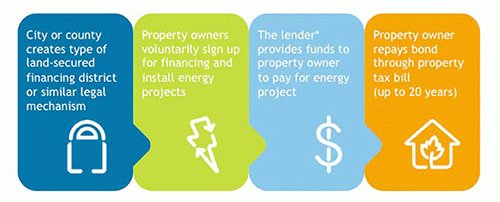by Andrea Cavanaugh
Opal is a homeowner who answered the door one day to a salesman, who asked if she wanted to install new windows and lower her utility bills. Opal said she would love to pay less for power, but that she didn’t have the money for expensive improvements. The man said not to worry; there was a government program that would let her make significant upgrades to her property, while initially paying nothing out of pocket. Before she knew it, Opal was enrolled in the Property Assessed Clean Energy Program, (PACE), and a contractor was busy installing new windows – along with solar panels and central air.
What Opal didn’t realize was that the salesman worked for the contractor, and the payments would be attached to her property tax bill. Opal’s annual income was less than $20,000, but while things were tight, she was able to make ends meet, partly because she had owned her home for decades, it was paid off, and her property-tax bill was low. She didn’t realize that she would have to make payments of around $5,000, that the payments were made along with her property taxes, and that she could lose her home if she missed installments.
Opal isn’t alone. Tens of thousands of homeowners in California and other states have financed projects through PACE. Some have lost their homes because they couldn’t afford the payments. Loans are typically for 5 to 20 years, and interest rates are often 6.5 to 8.5 percent. The loan stays with the property as a tax lien, so a new owner must take over the payments if the property is sold. This can hurt a property’s resale value.
Some consumers complained that they didn’t understand the financing terms or the consequences of defaulting on their PACE loans. In response, California passed laws in recent years that require PACE providers to:
- Assess property owners’ ability to pay before extending credit.
- Provide the terms of the loan both in writing and during a recorded phone call in one of six languages.
- Give owners a three-day right to cancel both the loan and the home-improvement contract without penalty.
- Quote the same price for improvements as for a property owner paying cash.
- Lenders also are not allowed to tell contractors how much homeowners are able to borrow.
PACE can be a valuable tool for property owners who want to spread out the cost of energy improvements. However, it pays to shop around, as with any big-ticket purchase. Keep the following tips in mind when considering a PACE loan:
- There are a variety of financing sources for home-improvement projects, and some may ultimately cost less and offer more flexibility.
- Interest rates and prices vary even among PACE providers, so talk to several lenders and contractors to make sure you’re getting the best deal.
- Read the contract and make sure you understand the payment details and consequences if you can’t pay.








